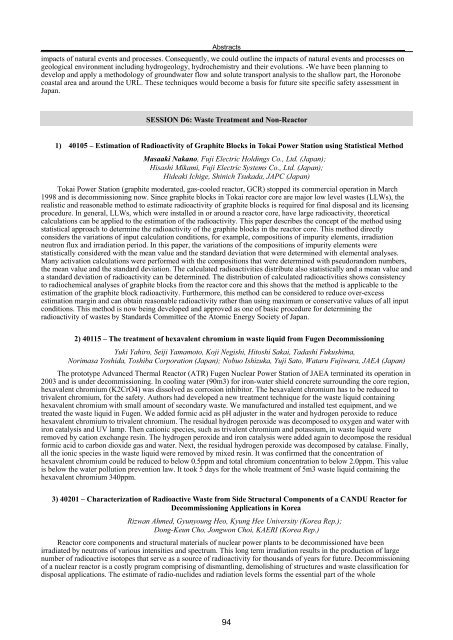The 13th International Conference on Environmental ... - Events
The 13th International Conference on Environmental ... - Events
The 13th International Conference on Environmental ... - Events
You also want an ePaper? Increase the reach of your titles
YUMPU automatically turns print PDFs into web optimized ePapers that Google loves.
Abstracts<br />
impacts of natural events and processes. C<strong>on</strong>sequently, we could outline the impacts of natural events and processes <strong>on</strong><br />
geological envir<strong>on</strong>ment including hydrogeology, hydrochemistry and their evoluti<strong>on</strong>s. -We have been planning to<br />
develop and apply a methodology of groundwater flow and solute transport analysis to the shallow part, the Hor<strong>on</strong>obe<br />
coastal area and around the URL. <str<strong>on</strong>g>The</str<strong>on</strong>g>se techniques would become a basis for future site specific safety assessment in<br />
Japan.<br />
SESSION D6: Waste Treatment and N<strong>on</strong>-Reactor<br />
1) 40105 – Estimati<strong>on</strong> of Radioactivity of Graphite Blocks in Tokai Power Stati<strong>on</strong> using Statistical Method<br />
Masaaki Nakano, Fuji Electric Holdings Co., Ltd. (Japan);<br />
Hisashi Mikami, Fuji Electric Systems Co., Ltd. (Japan);<br />
Hideaki Ichige, Shinich Tsukada, JAPC (Japan)<br />
Tokai Power Stati<strong>on</strong> (graphite moderated, gas-cooled reactor, GCR) stopped its commercial operati<strong>on</strong> in March<br />
1998 and is decommissi<strong>on</strong>ing now. Since graphite blocks in Tokai reactor core are major low level wastes (LLWs), the<br />
realistic and reas<strong>on</strong>able method to estimate radioactivity of graphite blocks is required for final disposal and its licensing<br />
procedure. In general, LLWs, which were installed in or around a reactor core, have large radioactivity, theoretical<br />
calculati<strong>on</strong>s can be applied to the estimati<strong>on</strong> of the radioactivity. This paper describes the c<strong>on</strong>cept of the method using<br />
statistical approach to determine the radioactivity of the graphite blocks in the reactor core. This method directly<br />
c<strong>on</strong>siders the variati<strong>on</strong>s of input calculati<strong>on</strong> c<strong>on</strong>diti<strong>on</strong>s, for example, compositi<strong>on</strong>s of impurity elements, irradiati<strong>on</strong><br />
neutr<strong>on</strong> flux and irradiati<strong>on</strong> period. In this paper, the variati<strong>on</strong>s of the compositi<strong>on</strong>s of impurity elements were<br />
statistically c<strong>on</strong>sidered with the mean value and the standard deviati<strong>on</strong> that were determined with elemental analyses.<br />
Many activati<strong>on</strong> calculati<strong>on</strong>s were performed with the compositi<strong>on</strong>s that were determined with pseudorandom numbers,<br />
the mean value and the standard deviati<strong>on</strong>. <str<strong>on</strong>g>The</str<strong>on</strong>g> calculated radioactivities distribute also statistically and a mean value and<br />
a standard deviati<strong>on</strong> of radioactivity can be determined. <str<strong>on</strong>g>The</str<strong>on</strong>g> distributi<strong>on</strong> of calculated radioactivities shows c<strong>on</strong>sistency<br />
to radiochemical analyses of graphite blocks from the reactor core and this shows that the method is applicable to the<br />
estimati<strong>on</strong> of the graphite block radioactivity. Furthermore, this method can be c<strong>on</strong>sidered to reduce over-excess<br />
estimati<strong>on</strong> margin and can obtain reas<strong>on</strong>able radioactivity rather than using maximum or c<strong>on</strong>servative values of all input<br />
c<strong>on</strong>diti<strong>on</strong>s. This method is now being developed and approved as <strong>on</strong>e of basic procedure for determining the<br />
radioactivity of wastes by Standards Committee of the Atomic Energy Society of Japan.<br />
2) 40115 – <str<strong>on</strong>g>The</str<strong>on</strong>g> treatment of hexavalent chromium in waste liquid from Fugen Decommissi<strong>on</strong>ing<br />
Yuki Yahiro, Seiji Yamamoto, Koji Negishi, Hitoshi Sakai, Tadashi Fukushima,<br />
Norimasa Yoshida, Toshiba Corporati<strong>on</strong> (Japan); Nobuo Ishizuka, Yuji Sato, Wataru Fujiwara, JAEA (Japan)<br />
<str<strong>on</strong>g>The</str<strong>on</strong>g> prototype Advanced <str<strong>on</strong>g>The</str<strong>on</strong>g>rmal Reactor (ATR) Fugen Nuclear Power Stati<strong>on</strong> of JAEA terminated its operati<strong>on</strong> in<br />
2003 and is under decommissi<strong>on</strong>ing. In cooling water (90m3) for ir<strong>on</strong>-water shield c<strong>on</strong>crete surrounding the core regi<strong>on</strong>,<br />
hexavalent chromium (K2CrO4) was dissolved as corrosi<strong>on</strong> inhibitor. <str<strong>on</strong>g>The</str<strong>on</strong>g> hexavalent chromium has to be reduced to<br />
trivalent chromium, for the safety. Authors had developed a new treatment technique for the waste liquid c<strong>on</strong>taining<br />
hexavalent chromium with small amount of sec<strong>on</strong>dary waste. We manufactured and installed test equipment, and we<br />
treated the waste liquid in Fugen. We added formic acid as pH adjuster in the water and hydrogen peroxide to reduce<br />
hexavalent chromium to trivalent chromium. <str<strong>on</strong>g>The</str<strong>on</strong>g> residual hydrogen peroxide was decomposed to oxygen and water with<br />
ir<strong>on</strong> catalysis and UV lamp. <str<strong>on</strong>g>The</str<strong>on</strong>g>n cati<strong>on</strong>ic species, such as trivalent chromium and potassium, in waste liquid were<br />
removed by cati<strong>on</strong> exchange resin. <str<strong>on</strong>g>The</str<strong>on</strong>g> hydrogen peroxide and ir<strong>on</strong> catalysis were added again to decompose the residual<br />
formic acid to carb<strong>on</strong> dioxide gas and water. Next, the residual hydrogen peroxide was decomposed by catalase. Finally,<br />
all the i<strong>on</strong>ic species in the waste liquid were removed by mixed resin. It was c<strong>on</strong>firmed that the c<strong>on</strong>centrati<strong>on</strong> of<br />
hexavalent chromium could be reduced to below 0.5ppm and total chromium c<strong>on</strong>centrati<strong>on</strong> to below 2.0ppm. This value<br />
is below the water polluti<strong>on</strong> preventi<strong>on</strong> law. It took 5 days for the whole treatment of 5m3 waste liquid c<strong>on</strong>taining the<br />
hexavalent chromium 340ppm.<br />
3) 40201 – Characterizati<strong>on</strong> of Radioactive Waste from Side Structural Comp<strong>on</strong>ents of a CANDU Reactor for<br />
Decommissi<strong>on</strong>ing Applicati<strong>on</strong>s in Korea<br />
Rizwan Ahmed, Gyunyoung Heo, Kyung Hee University (Korea Rep.);<br />
D<strong>on</strong>g-Keun Cho, J<strong>on</strong>gw<strong>on</strong> Choi, KAERI (Korea Rep.)<br />
Reactor core comp<strong>on</strong>ents and structural materials of nuclear power plants to be decommissi<strong>on</strong>ed have been<br />
irradiated by neutr<strong>on</strong>s of various intensities and spectrum. This l<strong>on</strong>g term irradiati<strong>on</strong> results in the producti<strong>on</strong> of large<br />
number of radioactive isotopes that serve as a source of radioactivity for thousands of years for future. Decommissi<strong>on</strong>ing<br />
of a nuclear reactor is a costly program comprising of dismantling, demolishing of structures and waste classificati<strong>on</strong> for<br />
disposal applicati<strong>on</strong>s. <str<strong>on</strong>g>The</str<strong>on</strong>g> estimate of radio-nuclides and radiati<strong>on</strong> levels forms the essential part of the whole<br />
94
















